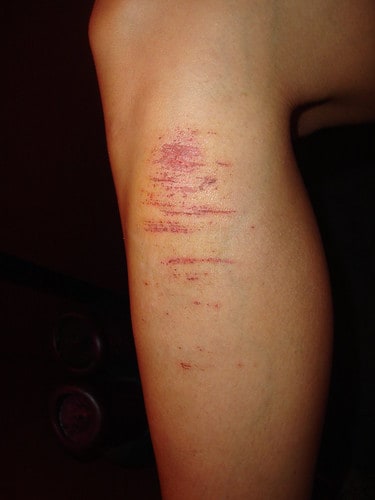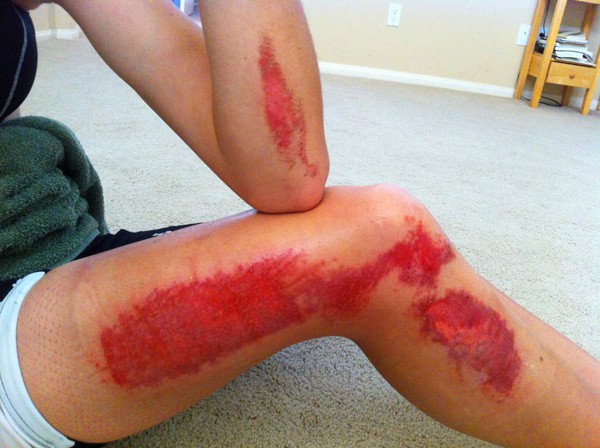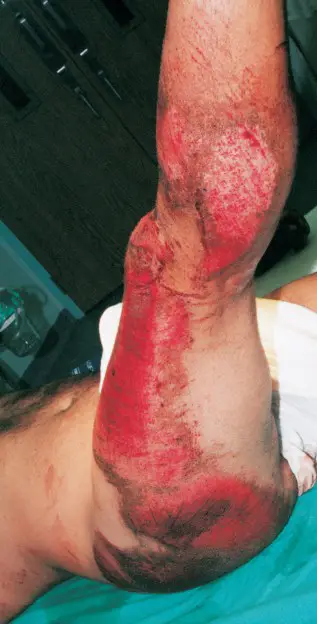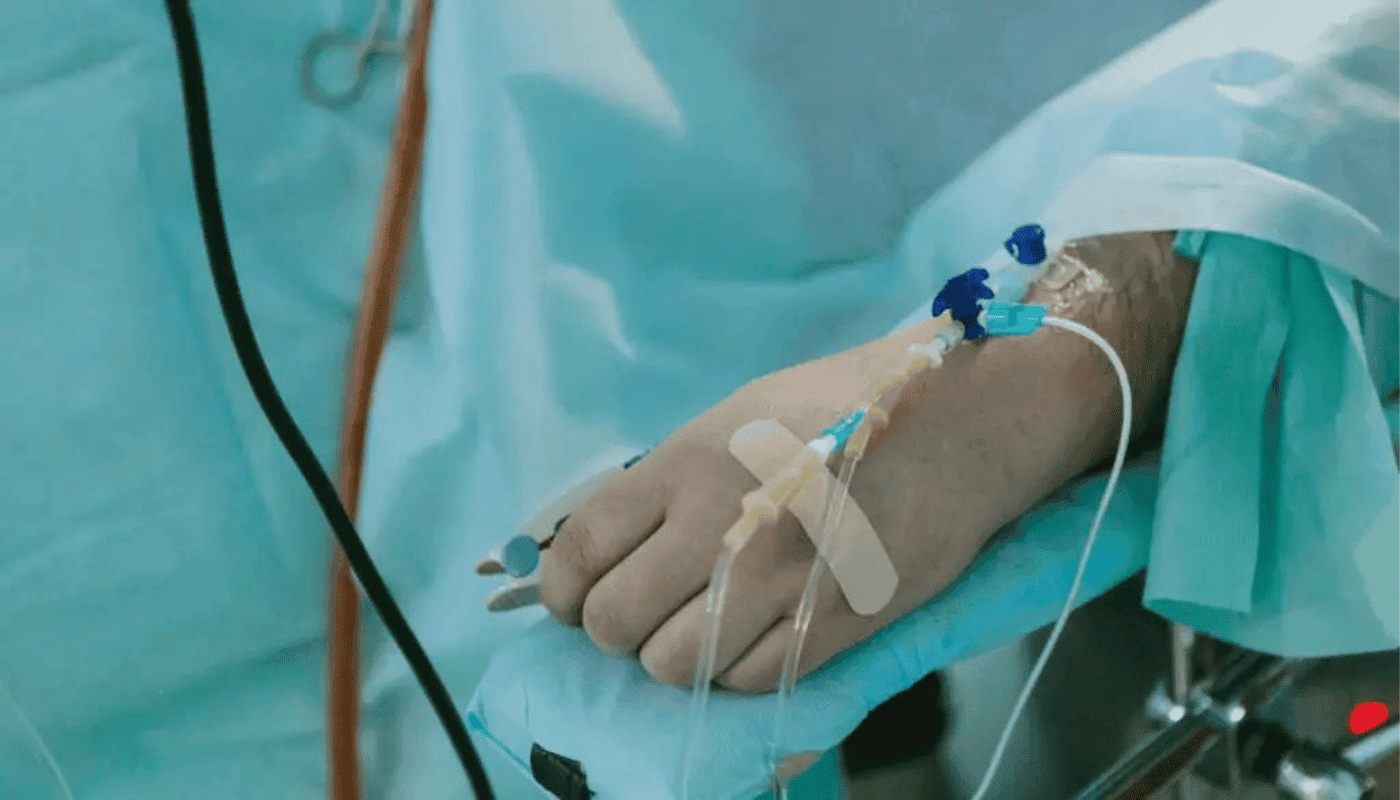Well it finally happened, you went down in your first motorcycle crash. Was it as bad as you thought? Were you geared up? Gear or no gear, it’s likely that you’ll have some various types of road rash somewhere on your body. Don’t worry though, you’re not the first and you certainly won’t be the last.
In the United States, over 80,000 motorcyclists are injured every single year. Not all of these are fatalities; some are completely treatable minor incidents, like road rash for example.
Road rash, also known as a friction burn or skin abrasion, is when the skin rubs against a rough surface like pavement or gravel after a motorcycle accident. While it can be painful, the good news is that most types of road rash injuries are treatable without needing to go to the doctor.
Are you a motorcyclist who has recently experienced road rash, or are simply curious about the topic? Here’s a comprehensive guide to understanding and treating your road rash.
WARNING: There are graphic images in this article as they pertain to motorcycle accidents and the subsequent related injuries. Read at your own caution.
What Is Motorcycle Road Rash?
Road rash is also referred to as gravel rash, friction burn, or abrasion. It’s the outcome of your skin rubbing against a hard and abrasive surface after you’ve had an unfortunate accident while riding your motorcycle.
The severity of the rash depends on how long the skin has been in contact with the road and how fast you were going when it happened. If you have just experienced road rash, it could look like small red patches or even more serious cases of open wounds that need immediate medical care.
[recent_post_carousel design=”design-1″]
Degrees of Road Rash
Road rash injuries vary in size and severity, but they’re medically categorized in degrees – similar to how burn injuries would be classified.

First Degree Road Rash
First degree road rash injuries may seem as minor injuries, but they can have serious consequences if left untreated. First degree road rash injuries are typically more of a friction-related injury. There are no gouges, debris, foreign objects, or otherwise severe aspects present to the injuries; moreso alike to dragging your soft skin across the carpet. I refer to these as “road rash burns”.
Symptoms of first degree road rash include:
- redness
- swelling
- pain at the site of the injury
- burning or stinging sensation
- slight bleeding
If you experience any of these symptoms after a motorcycle accident, it is important to seek medical attention immediately.
Ignoring first degree road rash can lead to infection and scarring, which can be both painful and unsightly. Don’t take chances with your health – take care of your injuries as soon as possible to ensure a speedy recovery.

Second Degree Road Rash
Second degree road rash injuries should not be taken lightly. It occurs when the top layer of skin is scraped off, exposing the second layer of skin.
Symptoms of second degree road rash include:
- intense pain
- swelling
- redness
- blistering
- slight bleeding
- potential nerve damage
If left untreated, it can lead to infection and scarring. It is important to seek prompt medical attention if you suspect you have second degree road rash. Don’t try to tough it out or treat it yourself. Your health and well-being are too important to risk. Trust the professionals to provide the care you need to heal properly and avoid any long-term complications.

Third Degree Road Rash
Third degree road rash injuries should not be taken lightly. It occurs when the skin is completely torn away, exposing all the layers of skin, muscle, bone, and other underlying tissue. Along with this, the suffer is likely to be experiencing other severe abrasions and extremely painful musculoskeletal ailments, like spinal cord injuries or otherwise broken bones.
The symptoms of third degree road rash include:
- severe pain
- excessive bleeding
- risk of infection.
- deep wounds
- permanent damage to nerve endings
- potential for broken bones
The wound may also appear black or brown in color and may have a foul odor.
If left untreated, severe cases of third degree road rash can lead to permanent scarring and even amputation should the wound get infected. It is important to seek immediate medical attention if you suspect you have third degree road rash. Don’t take any chances with your health – take action now to prevent further damage and ensure a speedy recovery.
It’s worth noting that it’s always worth incurring the related medical expenses of road rash treatment. I know everyone has a different financial situation, but what are finances without your life and well being?

How To Treat Road Rash from a Motorcycle Accident
Sometimes a road rash injury will warrant a visit to your nearest doctor. If the wound is deep and bleeding, you should seek medical treatment to ensure proper healing.
Minor road rash does not require professional medical treatment however, here are some tips for motorcycle road rash treatment at home:
- Clean the area with soap and water as soon as possible after a crash to remove any dirt, gravel or debris.
- Apply an antibiotic ointment to prevent infection and promote healing.
- Cover the wound with a sterile dressing or bandage to protect it from further damage. Iodine is also a good option for disinfecting the wound.
- Avoid scratching or picking at scabs as this can slow healing and increase the risk of infection.
- Use over-the-counter pain relievers like acetaminophen or ibuprofen to reduce discomfort and swelling.
- Apply cold compresses to help soothe the pain, reduce swelling and prevent further injury.
- Take short, lukewarm showers rather than baths to avoid irritating the wound. Avoid using harsh soaps or products that could dry out your skin.
- Keep the affected area clean and dry and covered with a sterile dressing until it is healed.
It’s important to remember that even when you adequately treat road rash, it can take several weeks or months to heal completely. During this time, you should take care to keep the wound clean and dry, and avoid activities that could aggravate it.
When To See A Doctor For A Road Rash Injury
Although most cases of road rash can be treated at home, some severe road rash injuries may require medical attention. If you experience any of the following symptoms, seek medical advice as soon as possible:
- The wound is deep or bleeding profusely. Blood is flowing out of the wound at a consistent rate.
- You can see bones or tendons in the wound.
- The skin around the wound appears to be infected or turning red and swollen, with pus draining from it.
- You have a fever, chills or feel generally unwell.
- You experience severe pain when touching the area of your road rash.
An injury like road rash may seem minor at first, but can become a much bigger problem if it’s not treated properly. By following the above steps, you can help ensure that your road rash heals quickly and without complications.
By the way, if you happen to have one of these symptoms.. it’s more likely that you have more severe injuries, not just of some run of the mill road rash.
How Long Does It Take Road Rash To Heal?
The healing process of road rash is going to be shorter or longer depending on a few factors.
First of all, how deep is the wound? If it’s a superficial burn, it may take several days to heal. However, if it’s a deep road rash injury, healing can take weeks or even months.
Second, are you taking care of your wound properly? Proper cleaning and bandaging will help ensure that your road rash wound heals quickly and without any complications. Frequently applications of an antibiotic ointment will expedite the healing process of road rash.
Finally, how severe is the infection? Road rash can become infected if not treated properly, and this will slow healing time.
The general advice given to road rash patients is to take things slow and give your wound about two weeks to heal properly.
To speed up your healing, it is also possible for motorcycle riders to find products that are designed specifically for treating road rash. Products like CrashPads were designed specifically to treat motorcycle related road rash.
How To Avoid Motorcycle Road Rash
The best treatment for motorcycle rash is prevention. If you know how to protect yourself and stay safe on the road, you’ll be far less likely to suffer from road rash. In other words, don’t involve yourself in a motorcycle accident, and follow the precautions below.
Wear Protective Gear
Clothing decisions are crucial as a motorcyclist – not for fashion reasons, of course, but for safety! Make sure you wear protective gear such as a helmet, gloves and pants that cover your arms and legs. I’ll tell you what, after the first time I suffered road rash, you wouldn’t catch me without my own protective clothing.
Leather is an excellent material for motorcycle clothing, as it offers protection against abrasions and is quite durable. It’s essentially a second layer of skin protecting your body from the road.
While some motorcycle clothing can be uncomfortable, especially in summer, it’s worth the sacrifice for your safety.
https://www.youtube.com/watch?v=OFBZUD7MGQk
Be Aware Of Your Surroundings
A benefit of riding motorcycles instead of driving cars is that you’re less tempted to be distracted by music or your phone. However, there are plenty of other distractions to take your focus off the road, such as people walking on the sidewalk or other vehicles.
As a motorcyclist, it’s absolutely crucial to be aware of your surroundings and pay attention to any potential hazards. Never assume that the people around you are paying attention to you, so be sure to stay alert and keep your eyes peeled. The first thing that people say after motorcycle accidents,”I didn’t see you!”.
Stick to Speed Limits
All drivers, whether in a car or on a motorcycle, should always follow the speed limits. While it may be tempting to go faster and feel the wind rush through your hair, you’ll also increase your risk of getting into a motorcycle accident, and therefore suffering aroad rash injury.
Going too fast for conditions, such as wet roads or heavy traffic, limits your ability to react appropriately and increases the risk of an accident. Even a slight acceleration on a wet stretch of road can cause a motorcyclist to lose control and fly off the bike.
Maintain Your Motorcycle Regularly
The importance of regular maintenance can’t be overstated. Make sure you check your tires and brakes often, as they are the most important components when it comes to maintaining control over your motorcycle.
Fluid levels should also be checked regularly, and any worn or damaged parts should be replaced immediately. Taking care of your bike will help ensure that you’re always in control while on the road and reduce your chances of getting into an accident.
It is much easier to maintain your motorcycle when you know how to clean a motorcycle the proper way. During riding season, I typically recommend detailing your motorcycle every month or so. This will allow you to keep a close eye on the condition of your bike, and sometimes, spot an issue before it becomes a bigger problem.
Monitor Traffic and Weather Conditions
Planning a road trip? Take the time to check the traffic and weather conditions before you leave. Heavy traffic or bad weather can increase your risk of getting into an accident, so you need to be aware of the potential hazards.
If you have to ride in bad weather, make sure you give yourself plenty of time and leave extra space between you and other vehicles. Even a small amount of water on the road can be enough to cause you to lose control and crash.
Remain Calm
There will always be inexperienced or intolerable people on the road – but if they do something frustrating or dangerous, don’t let anger take control. Staying calm is the best way to avoid an accident and protect yourself from road rash.
Try to maneuver away from unsafe people as quickly and safely as possible. The last thing you want is for your anger to cause you to make a mistake or do something reckless on the motorcycle.
You won’t always be able to prevent road rash by following these tips, but they can help you minimize your chances of getting injured. If you do get road rash, make sure to treat it with the appropriate first aid measures and see a doctor if necessary.
Getting Back On the Bike
Can you still ride after a motorcycle accident? The answer depends on the severity of your wound and how it’s healing – but most of the time, it’s possible to get back on the bike. Atleast speaking for the physical consequences, the psychological effects may linger.
If you’re feeling unsure or nervous about getting back in the saddle, practice some slow driving before you hit the highway. Take it easy and don’t push yourself too hard if your wound is still healing. You can also talk to your doctor for advice if necessary. There are also groups of motorcycle accident victims and survivors that are happy to chat with others in the same situation.
No matter what happens, don’t let a motorcycle accident stop you from riding. With proper treatment, you can make a full recovery and get back to enjoying the open road.
Can You Get Road Rash From Riding a Bicycle?
Yes, road rash can occur when riding a bicycle or any other two-wheeled vehicle if you are moving fast enough to cause friction between your skin and the ground.
Motorcycles are obviously much faster than bicycles, so you’re more likely to get road rash when riding a motorcycle. But no matter what kind of vehicle you’re driving, it’s important to be aware of the risk and take proper safety measures.
Will Road Rash Scars Disappear?
The amount of scarring you experience from road rash will depend on the severity of your wound. In some cases, you may not have any permanent scarring at all – but in more serious cases, the skin may become discolored or raised.
If you’re concerned about scarring, talk to a doctor who can assess your injury and recommend treatments to minimize its appearance. With proper treatment, you can help minimize visible scarring from road rash.
Can Road Rash Aggravate Other Injuries?
Yes, given that motorcycle accidents are most frequently traumatic. If you already have an existing injury, road rash can create further stress on your body, and make the healing process more difficult. Make sure to seek medical attention right away if you’ve been in a motorcycle accident or experienced any type of road rash.
Wrap Up
Road rash is a common injury among riders and ranges from superficial scrapes to more serious wounds. While it can be painful and cause scarring, there are treatments available to help reduce the severity of your injury and minimize the visibility of any scars.
Make sure you take proper safety precautions when riding a motorcycle and if you experience anything more severe than road rash – even if it doesn’t seem urgent at first. Taking these steps can help ensure that you heal as quickly as possible and reduce the risk of complications.
As with anything, if you’re in doubt.. don’t be afraid to consult a professional.
Conctacting Personal Injury Attorneys
If it’s on your mind, I highly suggest you seek compensation through a reputable motorcycle accident lawyer. Motorcycle accident attorneys work tirelessly, in the name of assisting motorcycle accident survivors like ourselves, to seek the maximum compensation available for medical bills you may have incurred.
A reputable law firm will typically offer a free consultation; if it’s on your mind, I recommend you do it – there’s not much to lose.
Videos
How to Treat Motorcycle Road Rash
https://www.youtube.com/watch?v=OFBZUD7MGQk








Leave a Reply
You must be logged in to post a comment.